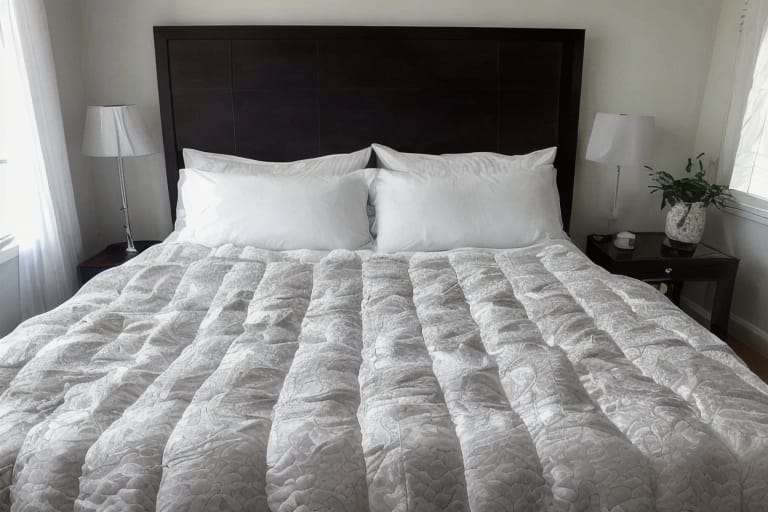A down comforter is a luxurious investment that provides warmth, comfort, and a touch of elegance to your bedroom. However, to maintain its quality and extend its lifespan, regular cleaning is essential. In this comprehensive guide, we’ll explore the importance of cleaning your down comforter, the benefits of washing it at home versus dry cleaning, cost savings, and how to keep your comforter in top condition.
Preparing Your Down Comforter for Washing
Before you begin the cleaning process, it’s crucial to inspect your comforter for any signs of wear and tear. Look for tears, loose feathers, or stains that may require special attention. If you find any damage, repair it before washing to prevent further deterioration. Spot cleaning is an effective way to tackle stains without subjecting the entire comforter to a full wash.
If your comforter has a duvet cover, remove it before washing. Duvet covers protect your comforter from dirt and stains, and they can be washed more frequently than the comforter itself.
Choosing the Right Washing Machine
When it comes to washing your down comforter, not all washing machines are created equal. Front-loading washers are generally preferred over top-loading machines because they are gentler on delicate items like comforters. They also use less water and energy, making them more environmentally friendly.
Consider the capacity and size of the washing machine you’ll be using. Down comforters are bulky, and they require ample space to move around during the wash cycle. If your home washer isn’t large enough, consider using a commercial washer at a laundromat.
Avoid machines with agitators, as they can damage the delicate fabric and cause the down to clump or shift unevenly.
Selecting Detergent and Additives
When washing your down comforter, it’s essential to use a mild, down-safe detergent. Harsh chemicals can strip the natural oils from the down, causing it to lose its loft and insulating properties. Avoid using fabric softeners, as they can leave a residue that attracts dirt and moisture.
If you prefer a more natural approach, you can create a homemade detergent using gentle ingredients like Castile soap or baking soda. Wool dryer balls or tennis balls can be added to the wash cycle to help fluff the comforter and prevent clumping.
Washing Cycle Settings
To ensure your down comforter is thoroughly cleaned without damage, use the following cycle settings:
- Warm wash, cold rinse
- Gentle or delicate cycle
- Double rinse cycles to remove all soap residue
It’s crucial to ensure that all detergent is completely rinsed out of the comforter, as any remaining soap can attract dirt and cause the down to clump.
Drying Your Down Comforter
Once your comforter is clean, it’s time to dry it. Use a low heat setting or air dry to prevent damage to the delicate fabric and down. Adding wool dryer balls or tennis balls to the dryer can help fluff the comforter and redistribute the down evenly.
If you notice any clumping or uneven distribution of the down, remove the comforter from the dryer and gently fluff it by hand. Continue drying until the comforter is completely dry to prevent mildew growth.
Alternative Cleaning Methods
In addition to machine washing, there are several alternative methods for cleaning your down comforter:
- Sunlight exposure: Hanging your comforter outside on a sunny day can help sanitize and freshen it naturally.
- Snow cleaning: If you live in a cold climate, you can place your comforter on clean snow and gently beat it to remove dirt and debris.
- Handwashing: For smaller comforters or those with delicate embellishments, handwashing in a bathtub using mild detergent can be an effective cleaning method.
- Professional cleaning: If you’re unsure about cleaning your comforter at home or have a particularly delicate or expensive item, consider using a professional cleaning service that specializes in down comforters.
Caring for Your Cleaned Comforter
Once your down comforter is clean and dry, it’s essential to store it properly to maintain its quality. Use breathable bags or containers, and avoid compressing the comforter or storing it in plastic, which can trap moisture and lead to mildew growth.
Before using your comforter after storage, give it a good shake and fluff to redistribute the down and restore its loft. Using a duvet cover can help protect your comforter from dirt, stains, and wear, extending the time between cleanings.
Frequency of Cleaning
The frequency at which you should clean your down comforter depends on several factors, including whether you use a duvet cover and your personal preferences.
| Usage | Cleaning Frequency |
|---|---|
| With duvet cover | Every 3-5 years |
| Without duvet cover | Every 1-2 years |
Signs that your comforter needs cleaning include visible stains, odors, or a flattened appearance. Always refer to the manufacturer’s recommendations for specific cleaning guidelines.

Cost Comparison: Home Washing vs. Professional Cleaning
Cleaning your down comforter at home can result in significant cost savings compared to professional cleaning services. While there are upfront costs for purchasing detergent and dryer balls, these items can be used for multiple washes, making the long-term costs more affordable.
| Cleaning Method | Average Cost per Cleaning |
|---|---|
| Home washing | $5 – $15 |
| Professional cleaning | $50 – $150 |
By extending the life of your down comforter through proper care and maintenance, you can save money in the long run by avoiding the need for frequent replacements.
Troubleshooting Common Issues
Despite your best efforts, you may encounter some common issues when cleaning your down comforter:
- Clumping or matting of down: This can be caused by insufficient drying or using the wrong type of detergent. To fix this, gently massage the clumped areas and redistribute the down by hand.
- Feather leakage or shedding: Small amounts of feather loss are normal, but excessive shedding may indicate a damaged comforter shell. Repair any holes or tears before washing to minimize feather loss.
- Shrinkage or damage to fabric: Using hot water or high heat settings can cause the comforter shell to shrink or become damaged. Always follow the manufacturer’s care instructions and use appropriate cycle settings.
- Mildew or odor problems: If your comforter develops a musty smell or mildew growth, it may not have been dried thoroughly after washing. To prevent this, ensure your comforter is completely dry before storing it and use a dehumidifier in damp environments.
Tips and Tricks for Optimal Comforter Care
- Use old socks or shoes to help fluff your comforter in the dryer, as they create more space for the down to move around.
- Spot clean small stains with a paste made from baking soda or a mixture of water and mild detergent.
- Dry your comforter in multiple short cycles rather than one long cycle to prevent overheating and damage.
- Rotate and fluff your comforter regularly to maintain its loft and prevent uneven wear.
Safety Precautions
When cleaning your down comforter, keep these safety precautions in mind:
- Avoid overloading washing machines or dryers, as this can cause damage to both the comforter and the appliance.
- Check your comforter for loose threads, buttons, or zippers that could become caught in the washing machine or dryer.
- Handle large, heavy comforters with care to prevent strain on your back and arms.
- Ensure proper ventilation when drying your comforter to avoid moisture buildup and mildew growth.
Extending the Life of Your Down Comforter
In addition to regular cleaning, there are several steps you can take to extend the life of your down comforter:
- Protect your comforter from spills and stains by using a duvet cover and addressing any accidents promptly.
- Rotate and fluff your comforter regularly to maintain its shape and prevent uneven wear.
- Store your comforter properly during off-seasons, using breathable containers and avoiding compression.
- Follow the manufacturer’s care instructions for your specific comforter to ensure optimal performance and longevity.
When to Replace Your Down Comforter
Even with proper care and maintenance, there may come a time when you need to replace your down comforter. Signs that it’s time for a new comforter include:
- Excessive wear or damage, such as large tears or thinning fabric
- Loss of insulating properties, resulting in decreased warmth
- Persistent odors or staining that cannot be removed through cleaning
- A cost-benefit analysis that indicates replacing the comforter is more economical than repairing or cleaning it
Choosing a New Down Comforter
If you find yourself in the market for a new down comforter, consider the following factors:
- Fill power and warmth ratings: Higher fill power indicates better insulation and loft, while warmth ratings help you choose the right comforter for your climate and personal preferences.
- Ethical sourcing and materials: Look for comforters made with responsibly sourced down and high-quality, durable fabrics.
- Size and weight: Choose a comforter that fits your bed size and provides the right amount of warmth without being too heavy or bulky.
- Duvet cover compatibility: Ensure your new comforter is compatible with your existing duvet cover or invest in a new cover that fits properly.
Conclusion
Cleaning your down comforter may seem like a daunting task, but with the right tools, techniques, and knowledge, it can be a straightforward process that saves you money and extends the life of your investment. By following the tips and guidelines outlined in this beginner’s guide, you’ll be well-equipped to keep your down comforter in top condition for years to come.
Remember to clean your comforter regularly, store it properly, and address any issues promptly to maintain its quality and performance. With proper care, your down comforter will continue to provide you with warmth, comfort, and a touch of luxury in your bedroom.

Frequently Asked Questions
- Can I wash my down comforter in a regular washing machine?
- It depends on the size of your comforter and the capacity of your washing machine. Front-loading machines are generally preferred for their gentleness and efficiency. If your home washer is too small, consider using a commercial washer at a laundromat.
- How often should I clean my down comforter?
- If you use a duvet cover, you can clean your comforter every 3-5 years. Without a cover, aim to wash it every 1-2 years or when it shows signs of soiling, odors, or flattening.
- Can I use regular detergent to wash my down comforter?
- It’s best to use a mild, down-safe detergent to avoid stripping the natural oils from the down. Harsh chemicals can damage the delicate feathers and affect the comforter’s insulating properties.
- How do I prevent my down comforter from clumping after washing?
- Add wool dryer balls or tennis balls to the wash and dry cycles to help fluff the comforter and redistribute the down evenly. Ensure your comforter is completely dry before storing to prevent clumping and mildew growth.
- Is it better to wash my down comforter at home or have it professionally cleaned?
- Washing your comforter at home can result in significant cost savings compared to professional cleaning services. However, if you have a particularly delicate or expensive comforter, or if you’re unsure about the cleaning process, it may be worth investing in professional cleaning for the best results and peace of mind.








